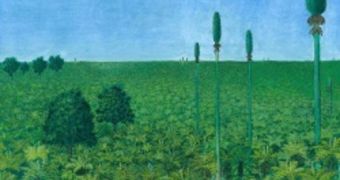In a finding that reminded experts of the ancient Roman city of Pompeii – which was buried “alive” under a thick layer of volcanic ash centuries ago – an international group of investigators recently discovered a 300-million-year-old forest that suffered exactly the same fate.
The tropical forest was alive in a region now located in northern China long before the dinosaurs developed, but was buried under a thick layer of ash shortly after a massive volcanic eruption occurred nearby. The study was led by University of Pennsylvania paleobotanist Hermann Pfefferkorn.
The expert, who is based at the Penn Department of Earth and Environmental Science, worked closely with Chinese Academy of Sciences expert Jun Wang, Shenyang Normal University scientist Yi Zhang and Yunnan University researcher Zhuo Feng.
Details of their remarkable investigation were published in the latest Early Edition of the esteemed journal Proceedings of the National Academy of Sciences (PNAS). The site where the petrified forest was discovered is located near the city of Wuda, in China.
The most remarkable aspect of this forest is that it is preserved exactly how it looked like when the volcano erupted. The majority of plants were covered by ash only a few days apart, and were found exactly on the spots where they grew.
Scientists rarely have access to location data when they study ancient animals or plants. Some fossils can be carried away from their original habitats, so every piece of data experts derive from their analyses is basically an assumption.
“It’s marvelously preserved. We can stand there and find a branch with the leaves attached, and then we find the next branch and the next branch and the next branch. And then we find the stump from the same tree. That’s really exciting.” Pfefferkorn explains.
Some of the smallest trees were found with intact leaves, branches, trunk and cones, providing a wealth of data of the type researchers never had access to before. It's not every day that they come across a fossilized forest.
According to a study that dated the deposits, the ash that covered the forest is around 298 million years old, meaning that it was produced around the start of the Permian epoch. At the end of the Permian came the Great Dying, the worst extinction event in our planet's history.
The new discovery “is now the baseline. Any other finds, which are normally much less complete, have to be evaluated based on what we determined here,” Pfefferkorn adds, saying that the group has thus far studied well over 1,000 square meters of fossilized forest.

 14 DAY TRIAL //
14 DAY TRIAL //